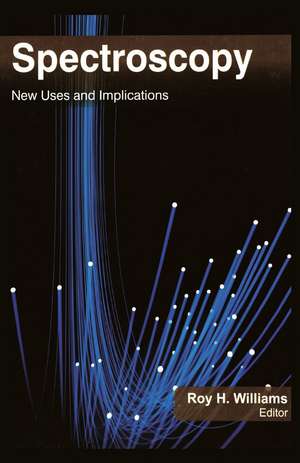Spectroscopy: New Uses and Implications
Editat de Roy H. Williamsen Limba Engleză Paperback – 31 mar 2021
Spectroscopy is a powerful technique that utilizes the interaction of light with matter. Analysis of various spectra can yield important physical characteristics of matter, including chemical composition, temperature, luminosity, mass, and more. The uses and implications of spectroscopy are very broad, with practical uses in many fields of science, including astronomy, medicine, analytic chemistry, material science, geology, and more. Researchers are constantly discovering new applications of spectroscopy, and it is expected to play an ever-increasing role in nanotechnology and superconductivity. This book brings together a diverse collection of new research advances in spectroscopy.
Preț: 579.62 lei
Preț vechi: 681.91 lei
-15% Nou
Puncte Express: 869
Preț estimativ în valută:
110.95€ • 116.56$ • 93.24£
110.95€ • 116.56$ • 93.24£
Carte tipărită la comandă
Livrare economică 11-25 martie
Preluare comenzi: 021 569.72.76
Specificații
ISBN-13: 9781774632475
ISBN-10: 1774632470
Pagini: 342
Dimensiuni: 156 x 234 x 18 mm
Greutate: 0.45 kg
Ediția:1
Editura: Apple Academic Press Inc.
Colecția Apple Academic Press
ISBN-10: 1774632470
Pagini: 342
Dimensiuni: 156 x 234 x 18 mm
Greutate: 0.45 kg
Ediția:1
Editura: Apple Academic Press Inc.
Colecția Apple Academic Press
Public țintă
Academic and PostgraduateCuprins
Collision-Induced Infrared Absorption by Molecular Hydrogen Pairs at Thousands of Kelvin. Non-Linear Dielectric Spectroscopy of Microbiological Suspensions. Near-Infrared Spectroscopy-Derived Tissue Oxygen Saturation in Battlefield Injuries: A Case Series Report. Rapid Etiological Classification of Meningitis by NMR Spectroscopy Based on Metabolite Profiles and Host Response. Traditional Biomolecular Structure Determination by NMR Spectroscopy Allows for Major Errors. A New On-Axis Multimode Spectrometer for the Macromolecular Crystallography Beamlines of the Swiss Light Source. High-Resolution 3D Structure Determination of Kaliotoxin by Solid-State NMR Spectroscopy. Kissing G Domains of MnmE Monitored by X-Ray Crystallography and Pulse Electron Paramagnetic Resonance Spectroscopy. In-Cell Biochemistry Using NMR Spectroscopy. Structure of the Dimeric N-Glycosylated Form of Fungal -N-Acetylhexosaminidase Revealed by Computer Modeling, Vibrational Spectroscopy, and Biochemical Studies. SAM Domain-Based Protein Oligomerization Observed by Live-Cell Fluorescence Fluctuation Spectroscopy. In-Vivo Optical Detection of Cancer Using Chlorin E6—Polyvinylpyrrolidone Induced Fluorescence Imaging and Spectroscopy. A Three-Dimensional Multivariate Image Processing Technique for the Analysis of FTIR Spectroscopic Images of Multiple Tissue Sections. Molecular Mapping of Periodontal Tissues Using Infrared Microspectroscopy. The Use of Coumarins as Environmentally-Sensitive Fluorescent Probes of Heterogeneous Inclusion Systems. Stereochemistry of 16 -Hydroxyfriedelin and 3-Oxo-16–Methylfriedel-16-Ene Established by 2D NMR Spectroscopy . Occipital Proton Magnetic Resonance Spectroscopy (1H-MRS) Reveals Normal Metabolite Concentrations in Retinal Visual Field Defects. Proton Nuclear Magnetic Resonance Spectroscopy Based Investigation on Propylene Glycol Toxicosis in a Holstein Cow. ATR-FTIR Spectroscopy Detects Alterations Induced by Organotin(IV) Carboxylates in MCF-7 Cells at Sub-Cytotoxic/-Genotoxic Concentrations. Raman Spectroscopy: The Gateway into Tomorrow’s Virology. Index.
Notă biografică
Roy H. Williams is an astronomer and educator at the Kopernik Observatory in Vestal, New York. He has trained on the spectrograph and is certified in both earth science and physical science. He has taught in several colleges. He writes a monthly column in the Press & Sun-Bulletin newspaper (Binghamton, NY) and makes monthly live appearances on local television newscasts. He also helped to create a computerized sky atlas using Turbo Pascal and in his role at Kopernik Observatory has worked with both astronaut Dan Bursch and astronomer John Dobson.
Descriere
This title includes a number of Open Access chapters.
Spectroscopy is a powerful technique that utilizes the interaction of light with matter. Analysis of various spectra can yield important physical characteristics of matter, including chemical composition, temperature, luminosity, mass, and more. The uses and implications of sp
Spectroscopy is a powerful technique that utilizes the interaction of light with matter. Analysis of various spectra can yield important physical characteristics of matter, including chemical composition, temperature, luminosity, mass, and more. The uses and implications of sp
